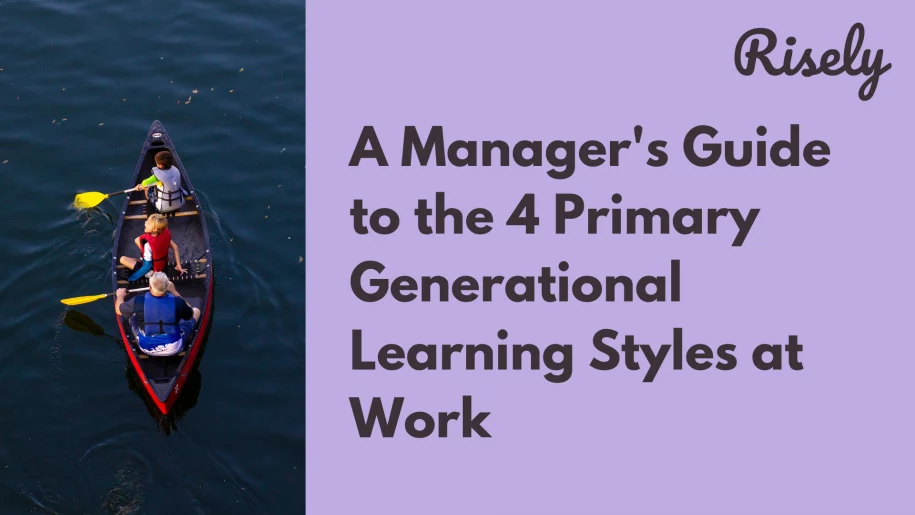A Manager’s Guide to the 4 Primary Generational Learning Styles at Work
As a manager, your role is to create an environment that helps your team learn and grow. But did you know that each generation has its unique learning style? Understanding these styles can help you create a more effective training program that caters to everyone’s needs. In this blog, we will explore the four primary generational learning styles in the workplace: Boomers, Gen Xers, Millennials, and Gen Z. We will also discuss how technology has impacted these styles and how you can cater to different learning preferences within your team. Lastly, we will provide tips on the critical skills needed for a successful learning and development manager in today’s workforce.- A Manager’s Guide to the 4 Primary Generational Learning Styles at Work
- Understanding Generational Learning Styles
- How does training work best for Baby Boomers?
- How do Gen Xers learn Best?
- What do Millennials need for Effective Learning?
- What Does Gen Z Want in Learning at Work?
- Catering to Different Generational Learning Styles in the Workplace
- Recognizing Learner Preferences in the Workplace
- Building a Learning Environment for All Generations
- Conclusion
- Understanding Generational Learning Styles
- Other Related Blogs
Understanding Generational Learning Styles
Understanding generational learning styles is crucial in a workplace comprising people of different ages. Baby boomers, Generation Xers, millennials (also known as Gen Y), and Generation Z each have distinct preferences regarding communication and feedback. As managers adapt their training and coaching styles accordingly by incorporating methods like hands-on experience or gamification for professional development opportunities, employees across all ages can be better engaged. It will create a positive learning environment that caters to learners’ diverse preferences.How does training work best for Baby Boomers?
Baby boomers are a generation of individuals born between 1946 and 1964, and they have significantly impacted the workplace. Baby boomers are known for their work ethic, loyalty, and dedication to their jobs. They tend to value stability, security, and traditional career paths and may be less likely to embrace new technologies or work practices. When it comes to training baby boomers, it is essential to consider their unique needs and preferences. Baby boomers may prefer face-to-face interactions and hands-on training with experience rather than online or virtual training. They may appreciate clear, step-by-step instructions that are easy to follow. Utilize a variety of multimedia elements, such as videos and graphics, to enhance the learning experience. Incorporate real-life scenarios and examples relevant to their work or personal lives. Encourage baby boomers to ask questions and provide opportunities for discussion and clarification.How do Gen Xers learn Best?
Generation Xers, born between 1965 and 1980, are a diverse group with varying learning styles. However, research suggests that many Gen Xers prefer hands-on, experiential learning over traditional lecture-based or theoretical approaches. They also tend to value flexibility and independence in their learning, choosing to work at their own pace and on their terms. Gen Xers may benefit from interactive and collaborative learning environments that allow them to work with others and apply their knowledge in real-world situations. Additionally, technology plays a vital role in the way many Gen Xers learn, with digital tools such as online courses, webinars, and mobile apps providing convenient and efficient ways to access information and continue learning throughout their lives. Overall, understanding the unique learning preferences of Generation X can help educators and trainers design more effective programs that meet the needs of this critical demographic.Other Interesting Reads
What do Millennials need for Effective Learning?
Millennials, like any other generation, have specific needs for effective learning. Managers must prioritize digital tools, collaboration, and personalized learning paths to engage millennials in learning. Interactive elements like gamification in training and group projects can improve engagement. Creating a culture of continuous learning is crucial to keeping millennial learners motivated. Millennials appreciate learning at their own pace and in their own way. It means providing options such as online courses or self-directed learning opportunities. This generation has grown up with technology and expects it to be integrated into their learning experiences. It can include tools such as e-books, interactive videos, and mobile apps. Millennials are used to working collaboratively and value peer-to-peer learning opportunities. Group projects or discussion forums can help facilitate this type of learning. Millennials want to know that what they’re learning applies to their lives and careers. Providing real-world examples or case studies can help make the material more meaningful and engaging.What Does Gen Z Want in Learning at Work?
Gen Z, or those born between the mid-1990s and mid-2000s, have grown up in an era of rapid technological change and are known for their tech-savvy approach to learning. According to research, Gen Z learns best through interactive, hands-on activities that allow them to apply what they’ve learned in real-world situations. They also prefer collaborative learning environments where they can work with others and share ideas and feedback. In terms of technology, Gen Z at work is comfortable with a variety of digital tools and platforms, such as social media, video conferencing, and online learning modules. To effectively engage Gen Z learners in the workplace, it may be helpful to incorporate these preferences like AI(artificial intelligence), AR (artificial reality), and VR (virtual reality) into training programs and other learning opportunities. It could include using interactive simulations or gamification techniques, offering opportunities for peer-to-peer mentoring or coaching, and providing access to digital resources that can be accessed on-demand from anywhere. Gen Z learners prefer visual and interactive learning experiences, are comfortable with digital tools, value flexibility, and personalization, and seek collaboration and feedback. Managers can engage them through multimedia, gamification, and social learning but should recognize that not everyone in this generation has the same preferences – personalization is a big hit in Gen Z!Catering to Different Generational Learning Styles in the Workplace
To cater to different generations of learners in the workforce and recognize generational differences in learning preferences, L&D managers must identify the four primary generational learning styles: Baby Boomers, Gen X, Millennials, and Gen Z. Younger generations, such as millennials, prefer self-directed educational opportunities using laptops or smartphones while older generations like baby boomers prefer traditional classroom settings. Therefore, developing training programs that cater to different age groups with varying learning preferences is critical. Recognizing learner preferences in the workplace and building a learning environment tailored to individual needs will ensure employee satisfaction and professional development opportunities.Recognizing Learner Preferences in the Workplace
L&D Managers need to recognize the generational learning styles and resultant difference in learning preferences when developing training programs for their workforce. For instance, younger generations, such as Millennials and Gen Z, are digital natives who prefer smartphones and laptops over traditional classroom learning. Baby boomers and Gen Xers value more self-directed and higher education opportunities for professional development. In catering to these differences, while designing training programs, L&D managers should identify primary learning styles and work towards a blended approach to cater to all age groups. By doing so, they can create a positive learning environment that recognizes the unique needs of each group of people.Building a Learning Environment for All Generations
Creating an effective learning environment for different generational learning styles requires recognizing their unique learning preferences. Visual learners appreciate images and videos, while auditory learners benefit from speaking and listening activities. Kinesthetic learners need hands-on experiences, while read-write learners value written material and note-taking. By utilizing these approaches in training programs, managers can engage employees across age groups and backgrounds through traditional methods or digital channels like email or social media. Encouraging self-directed professional development opportunities with laptops, smartphones, and internet access also accommodates younger generations like Gen Xers or digital natives. Read more: Understanding Motivation Of Training With 6 Effective Strategies And BenefitsConclusion
In conclusion, it’s essential for managers to recognize that different generations have different learning styles, and catering to those generational learning styles can lead to more effective training and development. By understanding the learning preferences of each generation, managers can create a learning environment that is inclusive and supportive for everyone. Additionally, with the increasing impact of technology on learning styles, managers need to stay up-to-date with new technological advancements and incorporate them into their training programs. As a Learning and Development Manager, developing skills such as flexibility, adaptability, and creativity are crucial to creating successful training programs that adapt to varying generational learning styles.Align learning with team growth – think strategically!
Take the free strategic thinking assessment for managers and leaders to test your skills now.
What is generational learning?
Generational learning refers to the process of acquiring knowledge and skills within a specific generation or age group. It recognizes that different generations have unique learning preferences, experiences, and perspectives that influence how they engage with educational content.
How can generations learn from each other?
Generations can learn from each other by fostering intergenerational collaboration and sharing knowledge. Older generations can pass down wisdom, experiences, and expertise to younger generations, while younger generations can offer fresh perspectives, technological savvy, and innovative ideas. This exchange of knowledge promotes mutual learning, understanding, and growth.
What are the 5 generations of learners?
The five generations of learners are:
Traditionalists/Silent Generation (born before 1946)
Baby Boomers (born between 1946 and 1964)
Generation X (born between 1965 and 1980)
Millennials/Generation Y (born between 1981 and 1996)
Generation Z/Zoomers (born after 1997)
Traditionalists/Silent Generation (born before 1946)
Baby Boomers (born between 1946 and 1964)
Generation X (born between 1965 and 1980)
Millennials/Generation Y (born between 1981 and 1996)
Generation Z/Zoomers (born after 1997)
Other Related Blogs
How to build a Learning and Development Action Plan ft Katie Greenwood
How to build a Learning and Development Action Plan ft Katie Greenwood Does your company’s Learning and Development (L&D) strategy feel like more “guessing” than “winning”? You’re not the only…
How to create training objectives for business success?
How to create training objectives for business success? Why are we conducting training? That’s where the story starts for all our training and development initiatives, which take the form of…
Learning at Work in the Age of AI
How is Learning at Work Shaping in the Age of AI? The traditional way of learning at work is changing fast because of AI. This change allows companies to improve…
Top 7 Learning and Development Trends 2025
Top 7 Learning and Development Trends 2025 It is no surprise that the world of learning and development is changing. A lot of innovation is happening in the space, particularly…


